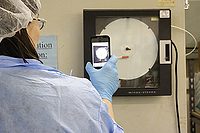

Table.
With the exception of joint replacements and most dental applications, medical applications for adhesives and sealants are relatively new; thus, many markets are experiencing fast growth off a small base. Opportunities are expected for cyanoacrylate, polyethylene glycol, and various plasma and protein types. Cyanoacrylate adhesives are projected to find greater use in external tissue-bonding applications. Rapid gains should result from the commercialization of several products presently in development, including cyanoacrylates for internal applications.
Medical applications will achieve more rapid growth than dental applications through 2011. In internal medical applications, adhesives and sealants will experience the best growth in situations where the tissue involved is affected by pressure caused by blood (e.g., capillaries, veins or arteries), air (e.g., the lungs), solids (e.g., the gastrointestinal system) or fluids (e.g., the dural membrane in the cranial region, the bladder or the spinal cord). In external medical applications, adhesives and sealants will find increased opportunities in external tissue bonding, particularly on low-tension wounds.
Dental applications will post annual growth of 4.1% through 2011. Good opportunities still exist, especially in newer products. For example, pit and fissure sealants will register strong gains due to their use in cavity prevention. Products such as denture adhesives, restorative adhesives and luting cements will see limited gains through 2011, primarily due to overall improved dental health in the U.S. population.
For more information, contact Corinne Gangloff, The Freedonia Group Inc., 767 Beta Drive, Cleveland, OH 44143-2326; phone (440) 684-9600; fax (440) 646-0484; e-mail pr@freedoniagroup.com; or visit www.freedoniagroup.com.
